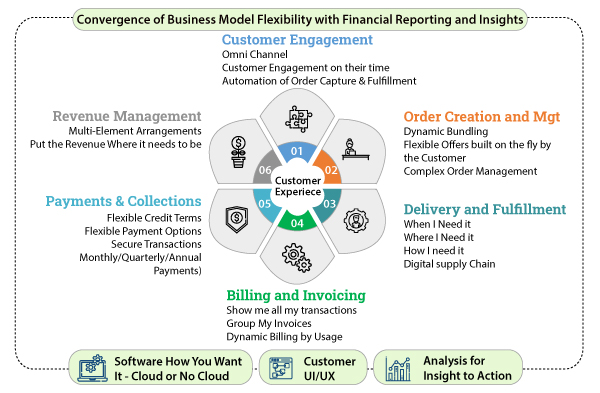This episode in our ongoing series on the Digital Solutions Economy (DSE) provides an overview of how DSE is impacting the electronics industry.
Previous episodes in this series include:
- DSE in Software and SaaS
- DSE in the Telecom Industry
- DSE in the Media and Entertainment industry
- DSE in the Semiconductor Industry
- DSE in the Medical Device industry
- DSE in Utilities industry
- DSE in the Energy Sector
- DSE in Transportation
Overview
Over recent years, makers of electronics products in both the consumer and B2B sectors have been increasingly turning to subscription-based Digital Solutions Economy offerings to improve customer relationships, increase revenues and provide better predictability.

Virtually all segments of the electronics industry have implemented or are considering subscription-based offerings, including OEM makers of devices and systems, as well as the parts manufacturers and distributors within the electronics industry supply chain.
Some examples include:
- Printer manufacturers offering subscriptions for ink, paper, and other supplies
- Industrial equipment makers offering subscriptions for maintenance, supplies, software-based upgrades and turnkey utilization management
- Home automation and security vendors offering monitoring services with options for consumption or usage based video storage
- Fitness and exercise equipment makers offering classes and coaching services
- Gaming console companies offering content libraries, avatars, and in-app purchases
- Electronic component makers offering developer kits, design support, and early access to new products or features
- Electronics distributors offering loyalty programs, discounts, and early access to new products
The key benefits of subscription-based DSE offerings include:
- Enhanced Customer Relationships: Subscription-based models allow manufacturers to build ongoing relationships with their customers. By offering regular updates, new products, and services, manufacturers can keep customers engaged and build loyalty over time.
- Predictable Revenue Streams: Recurring revenue streams from subscriptions can provide a more predictable source of income for manufacturers. This can help them plan and invest for the long term, rather than relying on variable sales of individual products.
- Improved Efficiency: Subscription-based models can also help manufacturers streamline their operations. By focusing on a smaller number of products and services that are regularly updated, they can optimize supply chains and reduce production costs.
- Increased Flexibility: Subscription-based models can also offer customers greater flexibility. For example, customers may choose from different subscription tiers, discounts, etc. based on their needs and budget, which can enable manufacturers to attract a wider range of customers and improve overall sales.
How DSE and Digital Transformation Solutions Apply to the Electronics Industry
In working with a range of mid to large size companies throughout the electronics industry ecosystem, the Bramasol team has seen good success at leveraging SAP solutions such as Billing & Revenue Innovation Management (BRIM) in conjunction with SAP Revenue Accounting and Reporting (RAR) to help electronics companies gain improved visibility and management over their end-to-end operational processes, boost customer empowerment, and integrate compliance mandates.

The combination of BRIM and RAR seamlessly integrate RevRec compliance processes for:
- Recognizing revenue at the point of sale or over the term of the subscription
- Accounting for bundling and entitlements within subscriptions
- Recognizing deferred revenue and unearned revenue
- Accounting for renewals and cancellations of subscriptions
The Bramasol team has developed a range of tools for helping client companies navigate the extensive set of capabilities in the BRIM portfolio in order to rapidly tailor and test working quote-to-cash-to-compliance processes for electronics products and components.
Looking forward, the path to SAP S/4HANA provides a solid roadmap for seamless meshing of DSE offerings within a high-performance, in-memory architecture that assures both scalability and future-proof extensibility. Also, the ability to leverage comprehensive agnostic analytics tools such as SAP Analytics Cloud will be key to enabling agile decision-making that takes into account timely data from all parts of the end-to-end process.
In addition, SAP's emphasis on cloud deployments (both Public and Private Cloud), along with implementation accelerators such as RISE with SAP make it easier for electronics companies to migrate their BRIM and RevRec based processes into cost-effective cloud environments.
Overall, subscription-based business models are becoming increasingly popular among electronics manufacturers and suppliers as a way to improve customer relationships, increase loyalty, and improve efficiency. By offering ongoing access to products and services with an end-to-end holistic approach, manufacturers can build long-term relationships with their customers and create a more sustainable source of revenue.
For More Information, check out these resources:
- Video: BRIM Overview
- Forecasting and Planning for the Digital Solutions Economy
- DSE and RevRec Compliance,
- DSE Data Volume, Velocity, Density and Complexity
- Embedded Analytics for DSE
- Podcast: SAP's Carla LeJeune on Optimizing Entitlement Management
- Podcast: SAP’s Pete Graham on Anything-as-a-Service and How SAP Enables XaaS
- Webinar video: Managing Entitlements in the Digital Solutions Economy
- Webinar video: Power Transition to DSE with SAP Cash and Treasury Management

